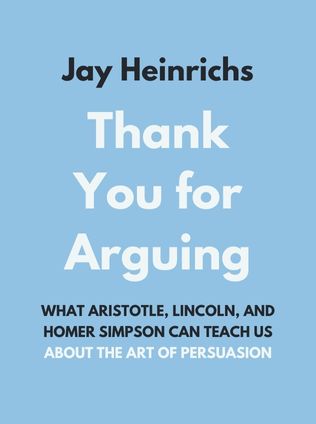
Thank You for Arguing
What Aristotle, Lincoln, and Homer Simpson Can Teach Us About the Art of Persuasion
By Jay Heinrichs
Published 02/2007
About the Author
Jay Heinrichs is a celebrated author, editor, and educator in the field of rhetoric. With over three decades of experience in publishing and education, Heinrichs has become a leading voice in reviving the ancient art of rhetoric for modern audiences. His most famous work, Thank You for Arguing, has become a staple for anyone interested in mastering the art of persuasion. Heinrichs's deep understanding of rhetoric is not only academic but also practical, making his teachings accessible and applicable to everyday situations.
Heinrichs originally wrote Thank You for Arguing in 2007, aiming to rekindle interest in rhetoric—a skill that he believes is essential for democracy and critical thinking. The book has since been updated multiple times, with the most recent edition in 2020 reflecting changes in political discourse and the influence of social media. Heinrichs teaches rhetoric at Middlebury College and continues to be an influential figure in promoting critical thinking and effective communication.
Main Idea
Thank You for Arguing is a comprehensive guide to the art of persuasion, drawing on classical rhetoric and applying it to contemporary issues. Heinrichs argues that rhetoric is not just a tool for politicians and lawyers, but a valuable skill for everyone. Whether in personal relationships, business negotiations, or public debates, understanding and mastering rhetoric can help individuals persuade others, make better decisions, and contribute to a more thoughtful and democratic society.
The book covers the essential components of rhetoric, including the three persuasive appeals—ethos, logos, and pathos—and how they can be used effectively in arguments. Heinrichs also explores the importance of understanding your audience, choosing the right goal for your argument, and using the appropriate tense to focus the discussion. Throughout the book, Heinrichs provides practical examples and anecdotes to illustrate the power of rhetoric in everyday life.
Table of Contents
- Introduction: The Building Blocks of Persuasive Argument
- Choose Your Goal
- Choose the Right Tense
- Choose Your Argument’s Appeal
- Use Ethos to Persuade Your Audience
- Use Logos to Persuade Your Audience
- Use Pathos to Persuade Your Audience
- Rhetoric’s Revival
Introduction: The Building Blocks of Persuasive Argument
Heinrichs begins by explaining that the essence of a persuasive argument is not about defeating your opponent but about convincing them. A successful argument has three essential parts: a clear goal, a focus on the right issue, and an appeal to the right audience. Understanding these components is crucial for constructing an argument that resonates and achieves the desired outcome.
"The purpose of an argument isn’t to beat your opponent, but to persuade them." — Jay Heinrichs
This idea shifts the focus from confrontation to collaboration, suggesting that the true power of rhetoric lies in its ability to build consensus and guide decisions.
Choose Your Goal
The first step in any argument is to determine the outcome you want. Heinrichs identifies three possible goals: changing the mood, changing the mind, and inspiring action. Each goal requires a different approach and understanding which goal you are pursuing is key to selecting the right strategy.
Sign up for FREE and get access to 1,400+ books summaries.
You May Also Like
The Subtle Art of Not Giving a F*ck
A Counterintuitive Approach to Living a Good Life
By Mark MansonRich Dad Poor Dad
What the Rich Teach Their Kids About Money - That the Poor and Middle Class Do Not!
By Robert T. KiyosakiHow To Win Friends and Influence People
The All-Time Classic Manual Of People Skills
By Dale CarnegieI Am Malala
The Story of the Girl Who Stood Up for Education and Was Shot by the Taliban
By Malala YousafzaiQuiet: The Power of Introverts
The Power of Introverts in a World That Can't Stop Talking
By Susan Cain



















